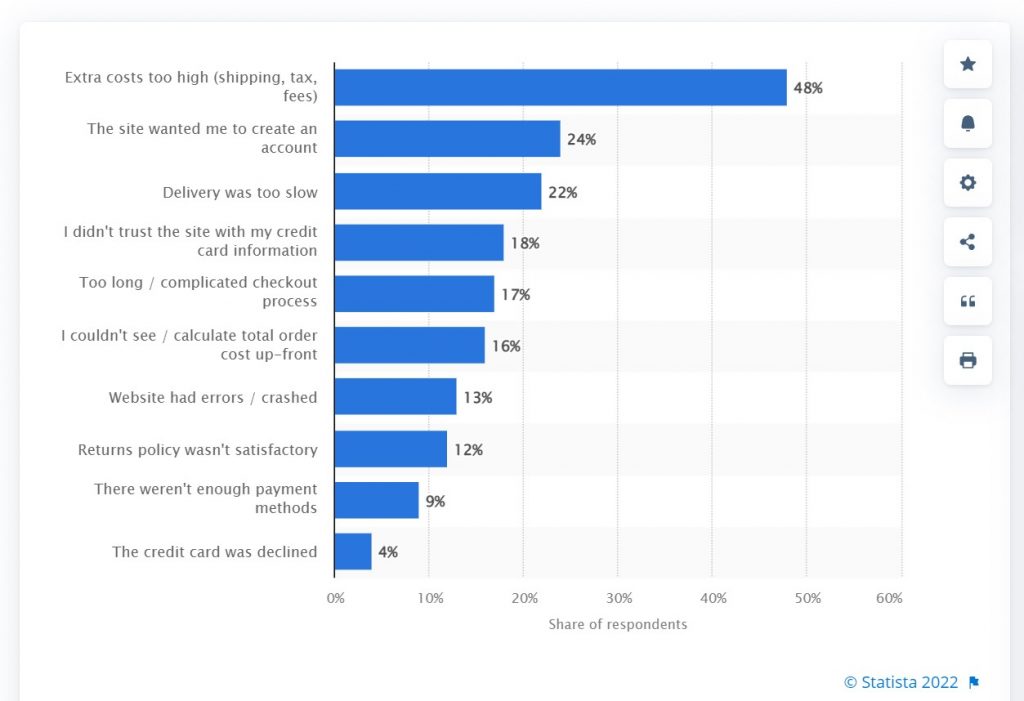6 Ways to Improve Trust of Your eCommerce Website
With customers being spoiled for choice when shopping online, building trust with them is essential for the survival and growth of any eCommerce business. Trusting you could be the main reason a consumer chooses to buy at your store over others. Thanks to the pandemic, the eCommerce industry is fast-growing and has become highly competitive. Young consumers grew up in the digital era. Hence, it is not surprising that they gravitate towards shopping online. They encounter more uncertainties when shopping online compared to in-store shopping, especially when there’s no face-to-face interaction with the product and seller. As such, more challenges await online sellers.
The Challenges of Trust in eCommerce

Caption: Main reasons for cart abandonment in the US in 2022 (Source: Statista)
There is a shift in the market towards eCommerce. Hence, many look to the web and social media for reviews and recommendations (they are treated as vehicles of verification by consumers). eCommerce as we know it has become a social commerce environment. If nobody trusts you or says anything good about your business, you will never sell anything. People are paid to write good reviews to improve trust factor. How do we know if the reviews and recommendations are authentic? Is it not better to trust our research and base it on our gut instinct rather than rely on others? The thing is, there are genuine reviews and recommendations out there. People have to know where to look and how to spot suspicious ones.
Payment security and privacy issues come into play when consumers give out their information online. Also, there’s no personal interaction with the sellers and no physical seeing or touching of the products. Hence, people will only make purchases from online merchants they trust. Trust is an underlying psychological state that is challenging to manage. That said, you still have to address such challenges to gain the trust of your customers. If not, they will not think twice about leaving. After all, trust is the first step towards conversion and the cornerstone of ensuring eCommerce success.
6 Ways to Improve Trust of Your eCommerce Website
Although people vary, they can be influenced to trust you. So, how do you get your consumers to trust your eCommerce website?
1. Meet Customers’ Expectations
Understanding your audience is the first step towards a successful eCommerce business. You have to know your buyers to understand how best to sell. Your online store has to be all about meeting your consumers’ needs and expectations. When you do so, you give a positive and enjoyable shopping experience to them. Match and exceed your customers’ expectations. Answer any lingering questions and reduce uncertainties, so they will confidently part with their hard-earned money to do business with you.
What You Can Do
Build trust with your customers by helping them engage well with your products online. Use only quality and high-resolution images with relevant and detailed product information. For example, zoomed-in images inform the type of material used for the clothing, so your buyers will know what to expect. Products vary and may require different approaches. Whatever it is, you must address the questions in your buyers’ heads. Use videos, especially for electronic products. They give your customers a better sense of the products and how to use them. Also, ensure your products are placed correctly in the suitable categories and that the search function is easy to use.
You can list the benefits but ensure you do so from how they address your customers’ pain points. Your customers will relate better. Also, reliable eCommerce hosting can help improve the online store’s performance and customer buying experience. Such a pleasant buying experience helps build trust.
2. Security and Privacy
Perhaps the biggest obstacle to online shopping is security and privacy concerns. Despite the numerous cybersecurity measures, many are still reluctant to transact online. They do not trust the safety of their payment and personal information; this is made worse by the increasing number of cybercrime incidents.
Trust in hacked online stores is almost zero and the effort to climb back up for most eCommerce businesses becomes insurmountable. Hence, security is especially imperative for any eCommerce website.
What You Can Do

Caption: Google Trusted Store badge strengthens your online store’s credibility (Source: Google).
Consider displaying trust badges; these are seals you use on your website to instill trust in buyers. They help confirm that your business is legitimate and can be trusted. For example, payment badges help boost confidence in buyers on acceptable payment methods. SSL-enabling your eCommerce website is a security necessity, as evident in the padlock at the side of your URL. A Secure Socket Layer (SSL) encrypts and protects information transacted on the internet. While all SSL levels provide encryption and data integrity, the Extended Validation (EV Certificate) is the highest form of SSL Certificate on the market.
Third-party endorsement badges help build your credibility; they are obtained via an application and approval process (Google Trusted Store badge). If you intend to target the European market, ensure your business adheres to GDPR rules to protect your buyers’ privacy. Also, always practice best practices for cybersecurity and privacy.
3. Be Consistent
Consistency is key to the success of every business. If you say something, stick to it and ensure you carry it out. Nobody wants to do business with a seller who is fickle. Giving empty promises guarantees a drop in sales. Nobody would ever return to a seller whom they cannot trust.
However, if you are consistent in everything you do, be it deliveries, product quality, refunds, and more, your buyers will not think twice about repeating orders from you. Also, frequent downtimes and slow-loading web pages frustrate user experience. Be consistent in delivering top-notch speeds and performance to your buyers.
What You Can Do
Ensure that updates in your products are across all sales channels simultaneously. Nothing is worse than getting differing information on each sales platform. Mean what you say and deliver what you promise, a motto you do well to always abide by. Inconsistent web pages with conflicting themes and layouts are the red flags to many that something is amiss. Suspicions linger, and trust drops. Hence, ensure your web pages are in sync for a consistent flow and easy-digestible navigation. People will learn to trust you.
Adopt programming best practices to optimize speeds and engage a trusted and reliable web hosting solution to ensure optimum uptimes. It is good practice to regularly check your eCommerce website’s load capacity to know precisely how many visitors it can reliably support. People do not like shopping at an online store with inconsistent performance.
4. First Impression Sticks
Your eCommerce website is your powerful sales agent 24/7, and its design is your brand’s silent ambassador. After all, your homepage is what your audience first sees when they land at your online store’s ‘doorstep.’ You have a couple of seconds before they form their first impression of your business.
Trust begins with a good and positive first impression. Since people are typically visual, they judge you based on your eCommerce website’s look and feel. An aesthetically pleasing website displays perfectly well across all devices, and leaves good first impressions. A well-structured and organized website makes for easily digestible content with easy navigation.
What You Can Do
Invest time into making your website shine in terms of usability and reliability. Also, sport a professional look. To do so, know your audience and cater to them. Your website’s layout must be clean and sleek, with enough white spaces to ease the eyes. Choose color palettes wisely and ensure they sync with the fonts, illustrations, and more.
Reduce the hierarchical levels in your menu and submenus for seamless navigation. Also, ensure your eCommerce website is adaptive across all devices. Any of the opposites frustrates your consumers; trust will be farthest from their minds. However, if you manage to get your design right, your consumers will happily stay and continue shopping at your online store as their trust in you increases.
5. Be Transparent
Being an eCommerce business owner, your online store gives zero physical presence. Hence, you rely on digital media to communicate with your buyers. All the more, you require greater transparency for your online business. Doing so convinces your buyers that you are not a fly-by-night business and are here to stay. It also shows your sincerity in doing business with them. Once buyers sense anything amiss (hiding fees or terms and conditions), they will not consider abandoning your store. Remember, transparency makes your business inviting to customers.
What You Can Do
Be upfront about everything your customers need to know. Display and inform on cancellation, refund, and return policies; make them easily accessible on your website. Also, ensure no hidden and last-minute fees. People do not like unexpected nasty surprises at checkout. Shipping, taxes, and others must be clear. A visible price breakdown is essential to gain your buyers’ trust.
Everything needs to be clear, upfront, and easy to understand. Once you have set the right expectations from the get-go, your buyers are more confident to make payments. You can also show your team behind the business. Your buyers want to see the people running the show.
6. Include Social Proof and Testimonials
One of the first things people do is head for the reviews and testimonial sections. These are valuable to them as they give an idea of your service and product’s quality. A 5/5 rating has more influential power over a customer’s purchase decision who still cannot decide.
Social proof and testimonials send strong signals to assure that others have purchased and used your products and your business is genuine. The information they provide allows your buyers to make a well-informed purchasing decision.
What You Can Do
Encourage your buyers to write reviews by incentivizing future purchases (vouchers or discounts). Highlight the good reviews and do not omit the negative ones. You’d want to show a neutral take on your reviews and testimonials. Also, display them as they are without editing anything. Consumers are cleverer by the day. They know how to spot the genuine from the fake ones. It is best if your reviews include images to strengthen their authenticity. Also, include social proof to showcase your standing in the market to build credibility.
Improve Trust of Your eCommerce Website – Wrapping Up
Ensuring your customers’ faith in your business is paramount if you are serious about your business. You must earn the trust of new buyers and learn to maintain the trust of existing ones. A tiny slip on your part can destroy the trust that took a long time to build; your business will tumble like a house of cards. Peruse the above list and follow through with them to win and improve trust of your consumers, a key ingredient in the eCommerce success recipe.




Leave a Reply